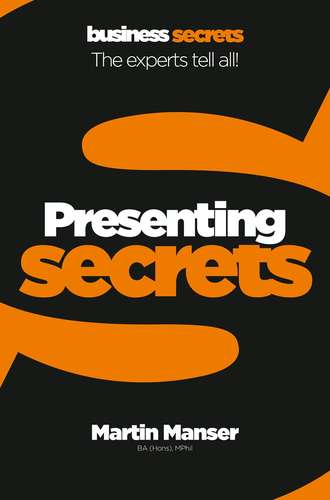
Полная версия
Presenting
satellite-navigation system. Find out what the car-parking facilities are. If you are travelling by train, check the railway timetable and where necessary book a taxi to take you from the railway station to the venue. Time spent on these matters in advance helps you feel more in control and prepared for possible delays or other unforeseen eventualities.
• Think through the arrangements at the venue. Who will meet you, where and at what time? Remember to allow sufficient time from arriving at the venue to when you are scheduled to begin your presentation, to allow time to freshen up.
• Check the lighting of the room. If possible, give your presentation in a room that has natural light.
• Consider the ventilation of the room If the air in the room is too hot and stuffy, your audience will become drowsy. On the other hand, you don’t want people to become cold. Check how to operate any airconditioning or heating systems.
Make sure your presentation is not spoilt by poor attention to the practicalities set by the venue.
1.9 Consider the seating and accessories
You need to think through the facilities that you will need for your presentation. In particular, the way in which your seating is arranged has an important effect on the success of your presentation.
What accessories will you need at your presentation? You will probably bring your own laptop; will a projector be provided? Check that the power supply is close to your electrical equipment or that an extension lead is available. Again, allow enough time to check that your laptop connects properly with the projector. Will you need a flipchart? Flipchart pens?
one minute wonder How powerful is your voice? If the room is large, will a microphone and amplification equipment be provided? You will need to make sure you know how the equipment works and practise using it if at all possible.
• Rows and horseshoes. Think through the seating arrangements. If your audience is large (over 30) and the seating is formal with little interaction, then the layout of seating in rows may be best. If the audience is 20-30 and there is room, then an arrangement in a horseshoe (semi-circle) works well. This allows participants to work in pairs or to talk to one another a little. The disadvantage, however, is that it does not facilitate teamwork or group discussion.
• Cabaret seating. If one of your aims is to develop teamwork, interaction and discussion among the participants, then seating around tables (‘cabaret style’) works well, with five or six seated at each table, allowing room for workbooks, water, pens, etc. A possible disadvantage is that some participants may only be able to see you as presenter or if they turn around from the table.
• Furniture for you. Think whether you will speak from a lectern or table, or without any furniture at all.
• Drinking water. Will water be provided for you or should you take a bottle and glass with you?
Whichever layout you choose, give clear instructions to the organizers in advance, but also allow time before your presentation to check that your instructions have been carried out.
The seating arrangement, equipment and accessories need to be planned in advance.
1.10 Plan your stages
When planning your presentation, think through as far as you can the practical details of each stage of what you plan to do. Some of these practicalities may be outside your control, but at least you will have thought of them. If you give presentations regularly, then it would be good to compile a check list of the various items.
1 Have the phone number of your contact. (Their phone number is probably more important than their email address.) Keep that phone number near you, or key it into your mobile so you can access it quickly if you are delayed.
case study Max tries to get to a venue early, well before the time the presentation is due to begin, especially if he is going into a company for the first time. Once, he arrived half an hour early and immediately began to notice who was talking to who…and who wasn’t talking to anyone else. One person offered to make Max a coffee, and colleagues expressed surprise as that person had never offered to make them a coffee. This information was helpful to Max later in the presentation when he encouraged colleagues who didn’t usually interact to start talking to each other and begin working as a team.
2 Know the time of your presentation: when you are due to begin and end; whether questions will be asked and, if so, if it will be during your talk or at the end. If they come at the end, will you chair the Question and Answer session or will someone else?
3 Know who will introduce you – or will you be expected to introduce yourself?
4 Know whether you bring your own handouts. Make sure you make enough photocopies in advance. Think about when you will distribute them.
5 Take your own pens, papers, post-it notes for last-minute changes and if necessary enough paper and pens for your audience.
Time spent planning the order of your presentation helps you stay in control.
Work on your words
The words you say are the single most important part of your presentation. You need to work hard at the verbal content, varying your style and choosing your words carefully to keep your message simple and clear. Here is practical advice on planning the beginning, middle and end of your speech, and working out a title for the presentation.
2.1 Keep your message simple
Start preparing your presentation, making sure that your material is not complicated and will not demand too much of your audience. The audience is more likely to take in your information and enjoy your presentation if you keep it simple.
• Identify your key messages. Think about what is the overriding point of what you are trying to say and break that down into a few (three to five) key messages. If you include more, you risk overloading your presentation. Less is more.
case study Emily’s talks on English grammar were too long. It was as if she were trying to communicate everything she knew on the subject. Gradually, Emily learnt that less is more. Her audience weren’t looking for a reference-book “give us all the 50 things you know” approach, but Emily’s personal appreciation of a subject: her own point of view on it. As she selected material that was appropriate to the audience and worked at expressing herself more simply, she gained happier, more responsive audiences.
Конец ознакомительного фрагмента.
Текст предоставлен ООО «ЛитРес».
Прочитайте эту книгу целиком, купив полную легальную версию на ЛитРес.
Безопасно оплатить книгу можно банковской картой Visa, MasterCard, Maestro, со счета мобильного телефона, с платежного терминала, в салоне МТС или Связной, через PayPal, WebMoney, Яндекс.Деньги, QIWI Кошелек, бонусными картами или другим удобным Вам способом.









